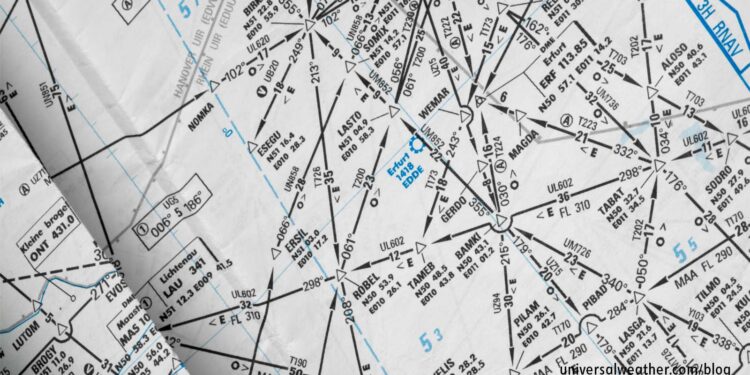Flight Route Planning Pitfalls: Part 2 – Complexities and Solutions

This business aviation blog post continues from our article last week, titled “Flight Route Planning Pitfalls: Part 1 – What to Watch For.”
For business aircraft operators, certain regions of the world are more complex than others in terms of route planning and associated restrictions. Understanding all the complexities upfront and planning well in advance – including having a Plan B – is best practice for avoiding the common flight route planning pitfalls.
The following are some tips you should know:
1. Route planning is more complex in some regions
While nearly all countries have a system of preferred routings, many consider the western hemisphere, and – in particular – North America, to be among the easiest in terms of route planning.
One example of a complex region is the Middle East, where a multitude of countries have their own preferred routings, and close attention is necessary to ensure you have all pertinent information.
By comparison, route planning for the African continent is relatively straightforward so long as published airways are used. However, the complexity here can be in terms of the number of permits you may require for multiple Flight Information Regions.
China is very particular regarding routes. In many cases preferred routings are revised on a regular basis.
Europe can be complex from a routing perspective due to very high traffic volume. Every route to, from, or through Europe should be submitted via Eurocontrol’s website to ensure it will be accepted. While random routes are frequently not accepted, Eurocontrol’s website will let you know if there’s an issue. It also provides suggested route options which have been recently accepted. Keep in mind that the day of the week, even the time of day, may affect routes within Europe.
2. Be aware of routing considerations for Atlantic ocean crossings
Over the North Atlantic, you deal with the North Atlantic Track system, designed to take best advantage of the Jetstream for both eastbound and westbound traffic. In the south Atlantic, there are Atlantic Ocean random route RNAV area restrictions between South America and Africa. While this is not a track system, you’ll need to comply with specific entry and exit fixes and provide lat/long updates every five degrees when operating between flight levels (FLs) 290-410 inclusive.
3. Be mindful of other types of routing restrictions
- Japan has complexities to consider in terms of approved routings. Preferred routings are normally published based on airport. In this region you’ll need to pay close attention to estimated times of departure and arrival as preferred routings can change based on time of day.
- Geopolitical considerations should always be at top of mind.
- Unless operating a B-registered aircraft, avoid routings between Taiwan and China. Traveling to/from Taiwan requires that you avoid Chinese airspace, and this may add additional time to your route.
- Israel may not be overflown, and restrictions exist for territories that may be overflown when departing Israel.
- Certain areas of the world – such as western China – have large areas with restricted airways. Published airways between China and Nepal are available only for airlines and may not be used by general aviation.
- There are typically large areas of restricted airspace around war zones.
In general, keep in mind that these potential routing complexities can be amplified whenever multiple permits are involved.
4. Take some simple steps to avoid pitfalls
Use all the resources available to you when building routings. Some of these resources are flight planning charts, flight planning systems, and Aeronautical Information Publications (AIPs). If you don’t have access to these resources, you’ll likely face issues with routings.
In addition it’s always best to utilize published preferred routings – even though they may be slightly longer – to ensure issues do not arise with permits, flight plan filing, or assorted regional restrictions.
5. Know best resources when planning international routings
The routing data in AIPs, charts, flight planning systems, flight management systems, etc., are typically updated regularly during the Aeronautical Information Regulation and Control (AIRAC) update. The AIRAC cycle – occurring every 28 days – applies the latest routing and airway changes worldwide. Sometimes, aviation charts are not distributed quickly enough to keep up with the latest changes. Also, electronic databases sometimes “glitch.” As a result discrepancies sometimes exist among your database, the latest airway charts, and published resources. When discrepancies are discovered, always check the AIP and any Notices to Airmen (NOTAMs) for updates.
6. Consider “plan B” backup routings
It’s always best practice to have a back-up route available – particularly when long lead time permits are involved. Many operators choose to secure permits for these back-up routings – in advance and at additional costs – just in case a re-route becomes necessary on the day of operation.
Closing thoughts
When considering international routings, plan early, and stay abreast of updates, NOTAMS, and airway revisions. Particularly if you’re unfamiliar with a new international routing, it’s best to utilize a well-experienced 3rd-party provider to determine preferred options.
Questions?
If you have any questions about this article or if you would like route planning assistance, contact me at lloydclark@univ-wea.com.




